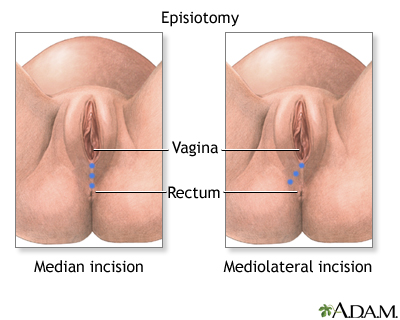| ||||||||||||||||||||||||||||||||||||||||
An episiotomy is a surgical procedure that enlarges the vaginal opening during labor by cutting the perineum, the skin and muscles between the vulva and anus.
Episiotomy is a procedure commonly performed on women in the United States. For decades, episiotomies have been performed on a routine basis to help speed delivery during the second stage of labor. They can also prevent tears to the mother's vagina, especially serious tears that may stretch to the anus. The procedure was also thought to lessen trauma to the baby and protect the mother's vaginal muscles. But there is disagreement in the medical field about the routine performance of an episiotomy. One large study showed that routinely cutting an episiotomy increases the risk of tears in the back of the vagina, but reduces tears in the front. Based on these results, the World Health Organization, among other groups, recommends avoiding episiotomy unless it’s absolutely necessary. According to the American College of Obstetricians and Gynecologists, between 1983 and 2000, the rate of episiotomies during vaginal deliveries fell from 70% to 20%.
Episiotomies May Be Useful Under The Following Conditions:
If an episiotomy is needed, then just before your baby is born, as the head is about to crown, your care health provider will inject a local anesthetic in the bottom of your vaginal opening and make an incision.
There are two types of incisions: median and medio-lateral. The median incision goes straight down the vagina toward the anus; the medio-lateral incision is made at an angle from the vagina to the anus. The medio-lateral is considered less likely to tear through to the anus, but is more difficult to repair and takes longer to heal than the median. Your health care provider will then deliver the baby through the enlarged opening, followed by the placenta. The incision is stitched closed immediately after delivery.

For most women healing is uncomplicated, although it may take several weeks. You can help speed the process by asking nurses to apply ice packs immediately following the birth.
To Continue The Healing Process Over The Next Few Weeks You Should:
To Help Relieve Your Pain And Discomfort You Should:
Your stitches do not need to be removed since your body will absorb them. Normal activities, such as light office work or housecleaning, can be resumed within a week after giving birth. Tampon use, intercourse, or any activity that might rupture the stitches, can be resumed in about a six weeks. Talk to your health care provider if you have any concerns.
There are several complications, including:
Q: Will I definitely tear if I do not have an episiotomy?
A: Studies show that tears are common during birth, but a large percentage of women who do not have episiotomies get through the birth process without a tear. Many factors influence whether or not you will tear during labor: the number of deliveries you have had, the duration of second (pushing) stage labor and the size and position of the baby.
Q: Won't an episiotomy heal better than a tear?
A: Studies show that episiotomies don't heal or repair better than tears. They often take longer to heal since the incision is usually deeper than a natural tear. In both cases, the vaginal opening must be stitched and properly cared for postpartum.
Q: What can I do to help avoid an episiotomy?
A: An episiotomy cannot always be avoided. Your obstetrician will decide if you should have the procedure based on the conditions of your labor. There are, however, activities you can do to strengthen the perineum, and these may lower your chances of undergoing the procedure. Practice Kegel exercises during your pregnancy; perform prenatal perineal massage (massaging the perineum for four to six weeks before birth makes it stronger); and practice the techniques you learned in childbirth class to control your breathing and your urge to push. But, keep in mind, that even with all these measures, an episiotomy may still be necessary.
|
Review Date:
12/9/2012 Reviewed By: Irina Burd, MD, PhD, Maternal Fetal Medicine, Johns Hopkins University, Baltimore, MD. Review provided by VeriMed Healthcare Network. |